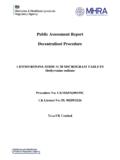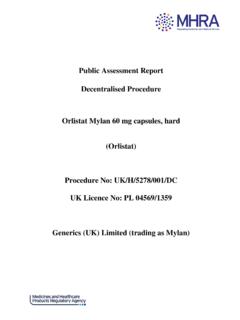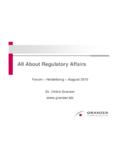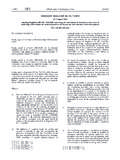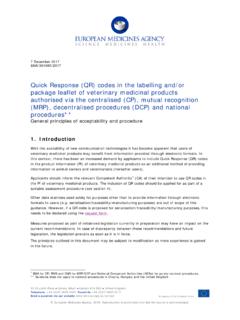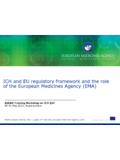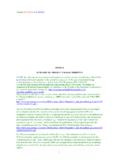Transcription of EU COMMUNITY REGISTER OF MEDICINAL …
1 E U C O M M UN IT Y R E GIST ER O F M ED I CI NA L P RO D UC TS - F R E Q UENT LY AS K E D QUES TIO NS The purpose of these FAQ s is to provide an overview on issues that have been frequently raised by the public in the context of the EU COMMUNITY REGISTER of MEDICINAL products. The information in this document is however, for guidance only, not complete, is simplified and may not be updated. Reference to the full legal texts can be found in the last question . April 2016 C ON TE NTS EU COMMUNITY REGISTER OF MEDICINAL PRODUCTS - frequently asked QUESTIONS .. 1 WHAT IS A MARKETING AUTHORISATION? .. 4 HOW LONG IS A MARKETING AUTHORISATION VALID? .. 4 HOW CAN A product BE AUTHORISED? .. 4 WHAT IS THE CENTRALISED PROCEDURE? .. 4 WHAT IS THE MUTUAL RECOGNITION PROCEDURE?
2 5 WHAT IS THE DECENTRALISED PROCEDURE? .. 5 WHAT IS A REFERRAL PROCEDURE? .. 5 WHAT PRODUCTS ARE AUTHORISED CENTRALLY BY THE EUROPEAN COMMISSION AND WHAT PRODUCTS BY THE NATIONAL AUTHORITIES OF THE MEMBER STATES? .. 5 HOW IS THE EU NUMBER COMPOSED? .. 6 HOW IS THE EMA (EMEA) PRO CE DURE NUMBER COMPOSED? .. 6 FOR CENTRALLY AUTHORISED PRODUCTS .. 6 FOR REFERRALS: .. 7 FOR ORPHAN DESIGNATIONS: .. 9 WHY ARE THERE EU NUMBERS MISSING IN THE CHRONO LO GICAL SERIES? .. 9 WHY DOES THE EU NUMBERING OF PRODUCTS NOT FOLLOW THE CHRONOLOGICAL ORDER OF AUTHORISATION? .. 9 WHY IS THE product I CAN BUY IN MY LOCAL PHARMACY NOT LISTED IN THE COMMUNITY REGISTER ? .. 9 WHY CAN T I BUY THE product LISTED IN THE COMMUNITY REGISTER IN MY LO CAL PHARMACY? .. 9 WHY THE DATA ON THE PROCEDURES IN THE COMMUNITY REGISTER ARE NOT AVAILABLE THE DAY THE DECISION IS TAKE N ?
3 9 WHAT IS MEANT WITH MINOR - AND MAJOR VARIATIONS? .. 10 CAN I BE ALERTED TO CHANGES IN THE EU COMMUNITY RE GISTER FOR A SPECIFIC product OR GROUP OF P RO D UC TS ? .. 10 WHAT IS I NN? .. 10 WHAT IS EPAR? .. 11 WHAT IS A TC? .. 11 WHAT LANGUAGES ARE MEANT WITH THE CODES IN THE LANGUAGE SELECTORS? .. 11 WHY ISN'T THERE A COMMISSION DECISION FOR ALL VARIATIONS? .. 11 WHAT DO CONTAIN THE ANNEXES TO A DE CI SIO N? .. 12 FOR CENTRALLY AUTHORISED P RO DU C TS: .. 12 FOR REFERRALS: .. 12 FOR ORPHAN DESIGNATIONS: .. 12 WHY ARE PACKAGE PRESE NTATIO NS AND FULL EU NUMBERS NOT SHOWN IN THE CO MM UNI T Y REGISTER ? .. 12 WHAT STATUS CAN A MEDICINAL product HAV E ? .. 12 CAN I MAKE A LINK TO THE LATEST ANNEXES FOR A CE NTRALISED P RO D UC T ? .. 13 WHY IS IRISH (GAELIC) MISSING IN THE COMMUNITY RE G IS TE R ?
4 14 WHAT ARE PRODUCTS REGISTERED UNDER ARTICLE 126A OF DIR 2001/83/EC? .. 14 WHERE CAN I FIND MORE INFORMATION ON HOW THE AUTHORISATIONS AND THE FOLLOW- UP PROCESSES WORK? .. 14 W HA T IS A M A R K ETI NG A UT HO RIS ATI ON? Whether for human or veterinary use a MEDICINAL product must be the subject of a valid Marketing Authorisation (MA) before it can be placed on the market for sale and supply. The Marketing Authorisation Holder (MAH) has to market the product in compliance with the terms of the authorisation. MAs issued only allow the product in question to be marketed by the MAH in that EU Member State, unless the product has been authorised via the centralised procedure in which case a single MA (a COMMUNITY Authorisation) is granted by the European Commission and is considered valid in all EU Member States.
5 All applications for a MA are assessed based on supporting data provided for safety, quality and efficacy. A product only receives a MA if its benefits outweigh any risks. Not all products for which MA applications are submitted are subsequently granted a Marketing Authorisation. Some applications are refused due to insufficient and/or inadequate data. HO W L ONG IS A MA R KE T ING A UTHO R ISA TI ON V A LI D ? A national Marketing Authorisation (MA) is initially valid for five years from the date of first authorisation. At the end of the five year period it will be subject to renewal, which is a mechanism for reviewing the product to ensure the benefit/risk balance remains favourable. This review takes into consideration any further information obtained about the product from the experience gained of its use since it was first authorised, pharmacovigilance data.
6 This is to ensure that the product 's MA is still appropriate. Following this review the MA will be valid indefinately, or the MAH will be asked to submit another renewal in a further five year's time. HO W CA N A P R O D UCT B E A UT HOR IS E D ? There are four different routes to obtaining a Marketing Authorisation (MA) which result in the issue of three different types of MA ; a National only MA , a Mutually Recognised MA or a COMMUNITY Authorisation. These routes determine the procedures, processes and timelines used in progressing an application for a new MA in accordance with EU legislation. Once granted, the authorisation will be classified as nationally authorised, mutually recognised or centrally authorised. A nationally authorised product is one that has been assessed and approved on a national basis only, there has been no interaction with other Member States.
7 For information about nationally authorised products please visit the website of your national health authority (see: ). A mutually recognised product is one that has been assessed and approved at a European level involving at least two Member States, evaluated via the mutual recognition or decentralised procedure. For information about mutually recognised products please visit the MRI product Index (Human) (see: ) or the VMRI product Index (Vet) (see: ) A centrally authorised product is one that has been assessed and approved on a COMMUNITY level involving all EU Member States. W HAT IS THE C E NT RAL I SE D P R OCE D UR E ? The centralised procedure is a European authorisation route resulting in a centrally authorised product with a single Marketing Authorisation. If a product has been authorised using the centralised procedure it has been assessed on an EU wide basis and approved by the European Commission.
8 The European Medicines Agency (EMA) organises the process of evaluation using scientific expertise from the Member States. The centralised procedure is compulsory for some products and optional for others. Some products are not eligible for the centralised procedure. W HA T IS THE M UT UAL R E C OGN IT ION P R OCE D UR E ? The mutual recognition procedure (MRP) is a European authorisation route resulting in a mutually recognised product . Mutual recognition must be used when a product is already authorised in at least one Member State on a national basis and the Marketing Authorisation Holder wishes to obtain a Marketing Authorisation (MA) for the same product in at least one other Member State. The Member State that has already authorised the product is known as the Reference Member State (RMS).
9 The RMS submits their evaluation of the product to other Member State/s, these are known as Concerned Member States (CMS). The CMS is asked to mutually recognise the MA of the RMS. If the applicant is successful, the CMS will then issue a MA for that product permitting the marketing of that product in their country. W HA T IS THE D E C E NTR A L IS E D P RO C ED UR E? The decentralised procedure (DCP) is a European authorisation route resulting in a mutually recognised product (MRP). The difference between MRP and DCP is that a product must already be authorised in at least one Member State on a national basis in order for MRP to be used. DCP may be used if the product is not already authorised in any Member State, but does not want to use the centralised procedure, or the product is not eligible for the centralised procedure.
10 One of the proposed Member States will be asked by the applicant company to act as Reference Member State (RMS). The RMS does the initial evaluation of the product and issues a draft assessment report. The other Member States, known as the Concerned Member States (CMS), either agree with the RMS's evaluation or they ask further questions/raise objections. If all the issues are resolved and the application is successful, each Member State will then issue a MA for that product permitting it to be marketed in their country. W HA T IS A R E F E R RA L P R O C E D URE ? A referral is a procedure used to resolve issues such as concerns over the safety or benefit-risk balance of a medicine or a class of medicines. The medicine, or the class of medicines, is referred to the European Medicines Agency, so that it can make a recommendation for a harmonised position across the European Union (EU).











